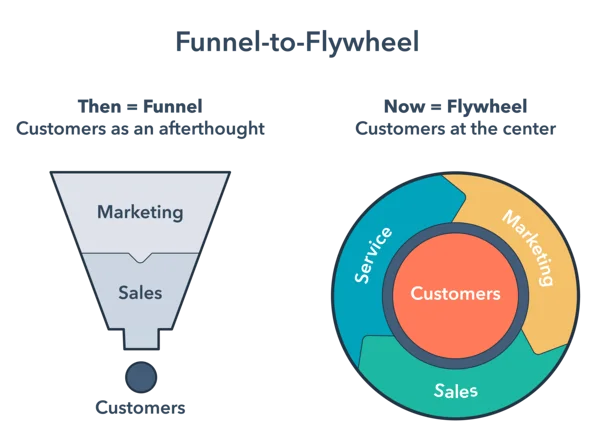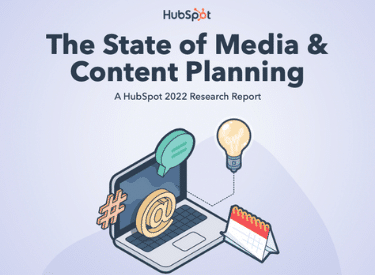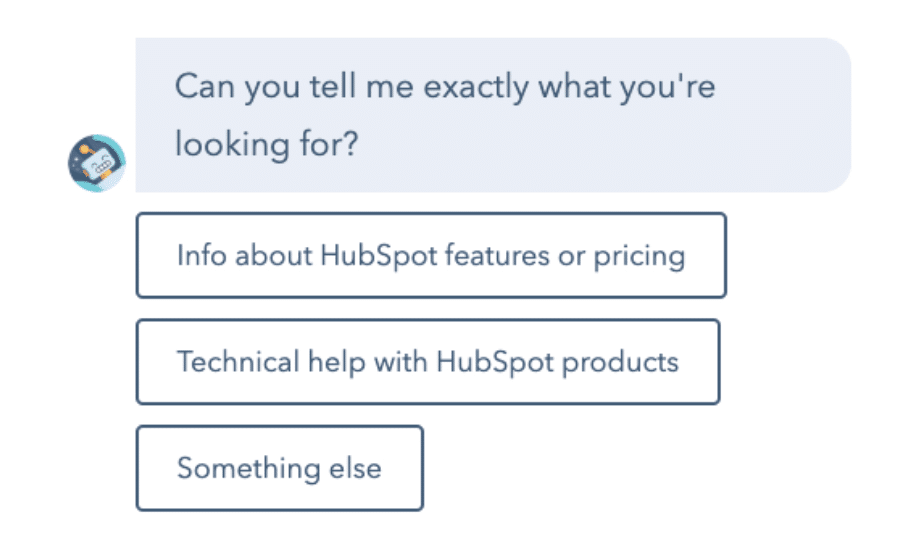Marketing Flywheel – The secret weapon of every B2B business

James Watt, the famed inventor of the steam engine, didn’t realize he was creating a blueprint for modern marketing when he designed the flywheel, a marvel of energy efficiency and continuous motion. Much like the steady rotation of the flywheel, where its momentum builds up over time, B2B businesses are employing the ‘Marketing Flywheel’ as a strategy that mirrors this energy-efficient invention.
The flywheel’s strength and success are influenced by its spin speed, the friction it counters, and its size. The ability to store energy becomes instrumental when applied to marketing; the more momentum your business builds, the more customers are drawn in and consequently contribute to your business growth.
Just as the wheels of a train or car maintain their constant and powerful movement through stored energy, so does the Marketing Flywheel use the persistent energy of customer interactions, word-of-mouth referrals, and ongoing engagement to drive a business forward.
Let’s explore the Marketing Flywheel in detail and understand how it compares with the traditional marketing funnel.
Flywheel Versus Funnel: Marketing Strategy 101
There has been a shift in perspective when it comes to understanding the customer journey. Traditionally, we used the marketing funnel model, consisting of stages like awareness, consideration, and conversion. The aim was to attract as many potential customers as possible, knowing only a fraction would eventually make a purchase. We focused on “widening the funnel” to maximize potential sales.
However, marketers have realized that this funnel model might not fully capture the customer journey in today’s dynamic market. This realization led them to the marketing flywheel model. Unlike the funnel, the flywheel places customers at the very center of every process, with the customers’ experience driving all growth. The model, inspired by Amazon’s business approach, follows the stages of
✔attract
✔engage
✔delight.

There are crucial differences between the funnel and the flywheel.
In the funnel, customers are seen as an output, whereas in the flywheel, they are the critical input. The funnel presents a constant start-stop rhythm every quarter, whereas the flywheel recognizes the ongoing momentum from customer loyalty and engagement. While the funnel emphasizes widening awareness, the flywheel focuses on customer success.

The flywheel concept, although relatively new, is being adopted by many companies. To shift from a funnel to a flywheel model, you need to reorganize your metrics and put more emphasis on delighting customers. Additionally, you need to identify and reduce areas of friction that could impede customer satisfaction.
How Customers Impact Your Flywheel
The Flywheel is a concept embraced by marketers to illustrate the momentum accrued when your entire organization is harmonized to provide an extraordinary customer experience. This model is extremely proficient in storing and discharging energy – a critical consideration in shaping your business strategy.
Contrasting models perceive customers as merely an outcome – nothing less, nothing more. The energy invested in acquiring that customer is squandered, leaving you back at the beginning.
Employing the flywheel concept, the momentum of your satisfied customers is utilized to stimulate referrals and recurring sales. In essence, your business maintains its momentum.
When you envision your business as a flywheel, it influences your decision-making and strategy adjustments.
Flywheel marketing breaks away from the conventional approach of merely treating customers as statistical conversions. It enables marketers to perceive customers as valuable assets, actively engaging them in the brand growth process. While traditional marketing funnels primarily target customer acquisition, the key aim of flywheel marketing is to leverage customers as catalysts for growth. Unlike other models that consider customers as secondary, the flywheel approach places them at the center, making them an integral part of your marketing strategy.
That said, friction in the flywheel can be caused by poor customer experiences or setbacks during the purchasing process. Customer frustrations – such as extended waiting periods or dissatisfaction with the delivered product – can generate negative energy. This friction naturally decelerates the momentum of your flywheel, potentially obstructing business development.
However, the adoption of a flywheel marketing strategy provides the tools to track momentum dips and pinpoint friction sources. This insight enables you to take the necessary steps to:
✔Understand the reasons behind customer grievances.
✔Construct a strategy to minimize friction as much as possible.
✔Establish a flawless customer experience.
Why Your Funnel Might Be Broken
There are fundamental flaws in the traditional marketing funnel, issues that have always persisted but were somewhat overlooked due to the simplicity and easy-to-understand nature of the model. However, it’s high time we address these shortcomings.
To take a step back: the marketing funnel was a concept introduced by John Dewey in 1910, which provided the first clear understanding of a customer’s journey from identifying a problem to purchasing a solution. This model served as an effective blueprint for marketers for a considerable time.
However, in today’s fast-paced world, capturing customer attention and persuading them to buy from us demands creativity and, importantly, momentum – a characteristic conspicuously missing in the marketing funnel model.
The funnel model presents the bottom as its smallest part, but in reality, it’s the most significant aspect. This model originated over a century ago, before the digital age when consumers can gain comprehensive knowledge about a product or service, and its competition, literally from the palm of their hand.
Presently, your potential customers use multiple devices, access multiple platforms, and approach your brand with varying purchase intents. The conventional marketing funnel model does not account for this complex reality.
In a nutshell, here are five fundamental reasons the funnel model is no longer adequate:
- It places an excessive focus on the top of the funnel.
- It falsely assumes that all consumers enter the journey from the top, which is not the case.
- It allows valuable effort and opportunities to leak from the bottom, leading to waste.
- It concentrates predominantly on acquiring new customers, rather than retaining existing ones.
- It fails to recognize that customers can enter the buying process at any stage.
Flywheel Marketing Models in Action
Upon the introduction of the flywheel marketing model, HubSpot revised its existing inbound methodology to align with this innovative framework, thereby laying the groundwork for effective flywheel marketing tactics. To ensure an exceptional customer journey with your brand, you can effortlessly integrate the three-phased inbound marketing methodology into each stage of your flywheel model.
Here’s a more detailed look at the Flywheel Model:
Attraction Stage:
As a marketer, your initial step should be crafting informative and valuable content that successfully draws new visitors towards your brand. When visitors interact with your content, they gain insights about your company and its offerings. The kind of content you generate should be meticulously tailored to resonate with your target audience. Depending on your audience, this might involve the creation of a diverse range of content marketing materials such as:
✔Blog posts that provide valuable insights into topics relevant to your audience.
✔eBooks offering a deep dive into complex subjects, showcasing your expertise.
💡Hubspot’s e-books provide thought leadership content and help generate leads.

✔Video tutorials and guides that provide visual, easy-to-understand instructions or information.
✔Engaging social media campaigns that promote interactive communication and brand visibility.
Engagement Stage:
After successfully attracting potential customers, your focus should shift towards nurturing these relationships. This step involves formulating a content marketing strategy that includes segmenting visitors based on shared characteristics or behaviors. You can then curate personalized content or promotional material for these segments, which specifically cater to their individual needs.
💡Important Note: This phase should not be viewed simply as a conversion point where leads are turned into sales. Instead, consider it as an opportunity to meaningfully engage with your visitors, aiming to foster long-term relationships. The momentum generated from these relationships significantly contributes to spinning your flywheel, thereby enhancing business growth.
Satisfaction Stage:
This stage, often referred to as the ‘delight phase,’ revolves around ensuring the success of your customers. Your objective should be to provide all possible support to enable your customers to reach their respective goals. This can be facilitated by several strategies, including:
✔Distributing customer feedback surveys after purchase to gain insight into their experiences and identify areas for improvement.
✔Based on customer feedback, making necessary user experience (UX) design changes to your website to enhance ease of use and satisfaction.
✔Integrating customer service chatbots on your website to offer instant assistance and answers to common queries, promoting a self-service culture.
💡Hubspot offers an improved customer experience with their chatbots.

✔Creating a community using your current customers and prospects.,thereby encouraging repeat business and deepening customer relationships.
💡The Salesforce Trailblazer Program is a classic example of a B2B community.

✔Designing a more streamlined and automated onboarding process, which can help new users understand and use your product or service effectively. This step significantly improves user experience and can directly influence customer retention.
Does Flywheel Marketing Work? The Amazon Example
In 2001, Jeff Bezos, a former student of Jim Collins, a Stanford professor, sought his mentor’s advice. In Collins’ renowned book, Good to Great, he outlines how he steered Amazon’s acceleration by presenting the flywheel marketing concept to the company’s leadership. Allegedly, Bezos even scribbled an early sketch of what has since evolved into the flywheel model on a simple napkin. Armed with this new approach, Bezos directed Amazon’s focus towards delivering outstanding customer experiences. He believed that this strategy would boost website traffic and motivate a greater number of brands to utilize the platform for product sales.
And the rest is history! We all know how it worked out for Amazon!
Flywheel Marketing Empowers Customers to Propel Business Expansion.
As customer trust in businesses begins to wane, the transition from funnel to flywheel marketing becomes increasingly crucial. Research conducted by HubSpot reveals some startling statistics:
81% of consumers place higher trust in the advice of friends and family compared to professional business advice.
65% of consumers exhibit mistrust towards paid ads, with a staggering 71% voicing skepticism towards sponsored social media ads.
55% of consumers concur that their trust in businesses has diminished over time.
💡The key insight: Contented customers who endorse your brand wield significant influence over sales decisions. Consider the multitude of sources people resort to for learning about a brand or a particular product, which are often not sales teams.
These sources encompass third-party websites like review platforms such as Google,G2.com & Product Hunt
Social media platforms also help users compare different products.
The crux of the matter is that customers not only have the potential but also the intent to shape future purchasing decisions. By pivoting from a funnel-centric marketing strategy to a customer-centric flywheel marketing model, you keep your customers as the core of your strategy. As your satisfied customers grow and continue to believe in your brand, it becomes increasingly effortless for you to attract new prospects and turbocharge business growth.
How to Set Up a Flywheel Marketing Model
To transition from funnel to flywheel marketing, it’s essential to establish integrated procedures that effectively monitor customer interactions. It’s important to note that customer experience fuels your flywheel. Hence, all your marketing initiatives should prioritize the construction of smooth purchase pathways and fostering positive engagements with your brand.
“Customer experience is the driving force of your flywheel.”
In this context, marketing software can prove highly instrumental in efficiently tracking your customers, pinpointing areas of inconvenience, and accumulating feedback about their experiences. Such digital tools include:
Sales Customer Relationship Management (CRM) systems.
CRM systems play a vital role in managing the relationships and interactions your business has with its customers and potential leads. They centralize customer information and record all interactions between the customer and the company. This data can provide invaluable insights about your customers’ behaviors, preferences, and pain points, enabling you to create personalized marketing campaigns and improve customer service. A well-implemented CRM can enhance customer retention and drive sales growth.
Examples are Salesforce & Hubspot.
Marketing automation applications.
These digital tools are designed to streamline and automate marketing tasks, making them more efficient and effective. From email marketing campaigns to social media posts, marketing automation applications can manage repetitive tasks across multiple channels. This allows marketers to focus on strategy and creative work, rather than on the technical aspects of implementation. More importantly, these tools can help you nurture leads with personalized content based on their interests and interactions with your brand, leading to a better conversion rate.
Examples are Hubspot’s Marketing Hub & Omnisend
Content Management System (CMS) platforms.
A CMS platform enables the creation, management, and modification of digital content, often without the need for specialized technical knowledge. With a CMS, marketers can quickly update website content, add new blog posts or products, and create landing pages for campaigns. An efficient CMS also facilitates SEO optimization, content scheduling, and integration with other marketing tools, helping to enhance the visibility of your brand and attract more visitors to your website.
Examples are WordPress & Drupal.
Customer feedback tools and review generators.
These tools offer an effective way to gather and manage customer reviews, both positive and negative. They provide a platform for customers to voice their experiences, which can give you insights into what’s working well and what areas need improvement. Additionally, they can help build trust with potential customers, as many people rely on reviews when making purchasing decisions. By actively seeking feedback, you not only show customers that their opinion matters but also get valuable information that can be used to improve the customer experience, ultimately boosting customer satisfaction and loyalty.
💡SurveyMonkey is a popular tool for creating online surveys to gather customer feedback. It offers a wide variety of question types and customization options. For review generation, Trustpilot is a platform where businesses can invite customers to review their experiences, improving the brand’s reputation and trustworthiness.
While crafting a flywheel marketing model, it’s beneficial to bear in mind these best practices associated with flywheel marketing:
Grasp the three central areas of focus in inbound marketing — attract, engage, and delight — and utilize them to guide customers through the purchasing cycle.
Implement metrics — like cost per acquisition, retention rates, and email signups — for each stage.
Scrutinize customer interactions for sources of friction and promptly address any concerns.
Regularly evaluate your outcomes and seek avenues to continually enhance the cycle.
Above all, during every phase of the flywheel marketing model, the customer experience should remain the heart of your entire operation.
Transform Your Marketing Strategy and Propel Your Business Growth
Transitioning from funnels to flywheels may seem overwhelming, yet it’s undoubtedly rewarding. By centering your marketing initiatives around superior customer experiences, you’ll cultivate a community of devoted customers willing to champion your brand. The outcome? Your business will draw new prospects, foster committed customers who persist in endorsing your brand, and eventually enhance its income.
However, it’s crucial to remember that this isn’t the initial — and assuredly not the final — instance where marketing approaches have transformed to foster more lucrative expansion.

